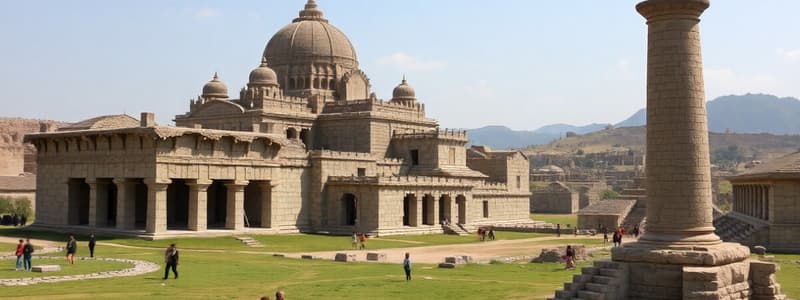Podcast
Questions and Answers
What point does Dr. Warren Perry emphasize regarding the achievements of ancient civilizations?
What point does Dr. Warren Perry emphasize regarding the achievements of ancient civilizations?
- They were solely the results of individual genius.
- They were made possible through the exploitation of many people. (correct)
- They can be replicated easily with modern technology.
- They represent the height of cooperative social structures.
What does the Despair, Inc. poster about the pyramids at Giza imply about societal achievements?
What does the Despair, Inc. poster about the pyramids at Giza imply about societal achievements?
- Group efforts are undervalued in history.
- Historical successes can lead to modern inspirations.
- Achievements depend on technological advancements.
- Success often relies on having numerous expendable resources. (correct)
What percentage of wealth does the richest 1% control in the United States according to the information provided?
What percentage of wealth does the richest 1% control in the United States according to the information provided?
- 72%
- 43% (correct)
- 95%
- 28%
How much of the wealth does the top 5% control, as indicated in the content?
How much of the wealth does the top 5% control, as indicated in the content?
What is implied about the relationship between modern and ancient wealth distribution?
What is implied about the relationship between modern and ancient wealth distribution?
What does the caption on the Despair poster depicting the pyramids at Giza imply about societal achievements?
What does the caption on the Despair poster depicting the pyramids at Giza imply about societal achievements?
What does the term 'ureaus' refer to in Inspector Merer's context?
What does the term 'ureaus' refer to in Inspector Merer's context?
What percentage of total wealth is estimated to be owned by the top 5% of the population in the United States?
What percentage of total wealth is estimated to be owned by the top 5% of the population in the United States?
Which of the following statements is supported by the discovery of Inspector Merer's papyrus scroll?
Which of the following statements is supported by the discovery of Inspector Merer's papyrus scroll?
How does the statement about the '1% of the population' relate to the historical context of pyramid construction?
How does the statement about the '1% of the population' relate to the historical context of pyramid construction?
Flashcards
Ancient Civilization Exploitation
Ancient Civilization Exploitation
The impressive achievements of ancient civilizations were often made possible by the hardship and exploitation of the majority of the population.
Modern Wealth Inequality
Modern Wealth Inequality
A significant portion of wealth is concentrated in the hands of a small percentage of the population in many modern societies.
Pyramid Construction Labor
Pyramid Construction Labor
The construction of the pyramids relied on a large workforce, engaged in tedious and demanding tasks like transporting stone.
Wealth Concentration Statistic
Wealth Concentration Statistic
Signup and view all the flashcards
Inspector Merer
Inspector Merer
Signup and view all the flashcards
Occupy Movement
Occupy Movement
Signup and view all the flashcards
Unequal Wealth Distribution
Unequal Wealth Distribution
Signup and view all the flashcards
Despair, Inc. Poster
Despair, Inc. Poster
Signup and view all the flashcards
Despair, Inc. Posters
Despair, Inc. Posters
Signup and view all the flashcards
Papyrus of Inspector Merer
Papyrus of Inspector Merer
Signup and view all the flashcards
Study Notes
Ancient Civilizations and Exploitation
- Archaeological discoveries often showcase impressive feats of art, architecture, engineering, and science.
- However, these achievements frequently involved the subjugation and exploitation of the majority of the population.
- This dynamic is reflected in a "Despair, Inc." poster parodying inspirational imagery. A poster featuring the Giza pyramids highlights the concept of "expendable labor" as a crucial element of achievement.
Modern Economic Inequality
- Current global realities mirror those of the ancient world.
- A significant portion of the population (95%) holds less than 28% of wealth, while a small fraction (1% to 5%) control a much larger proportion (43% to 72%).
- This disparity was present in a past movement where people occupied sites of concentrated wealth.
Papyrus Documents the Pyramid Construction
- A 2013 papyrus scroll discovered by Pierre Tallet documents the work of "Inspector Merer."
- Merer oversaw a 160-worker crew called "The Escort Team of 'The Ureaus of Khufu at its Prow'."
- They transported limestone from quarries along the Nile to a Giza pyramid worksite.
- The limestone, precisely polished, was used for the pyramid's exterior.
- The papyrus details the physical labor and logistics of pyramid construction in a very literal way.
- The papyrus document offers a firsthand account of resource movement during construction of the Khufu pyramid.
- Importantly, no fantastical entities like aliens or Atlanteans are mentioned in Merer's account.
Studying That Suits You
Use AI to generate personalized quizzes and flashcards to suit your learning preferences.





